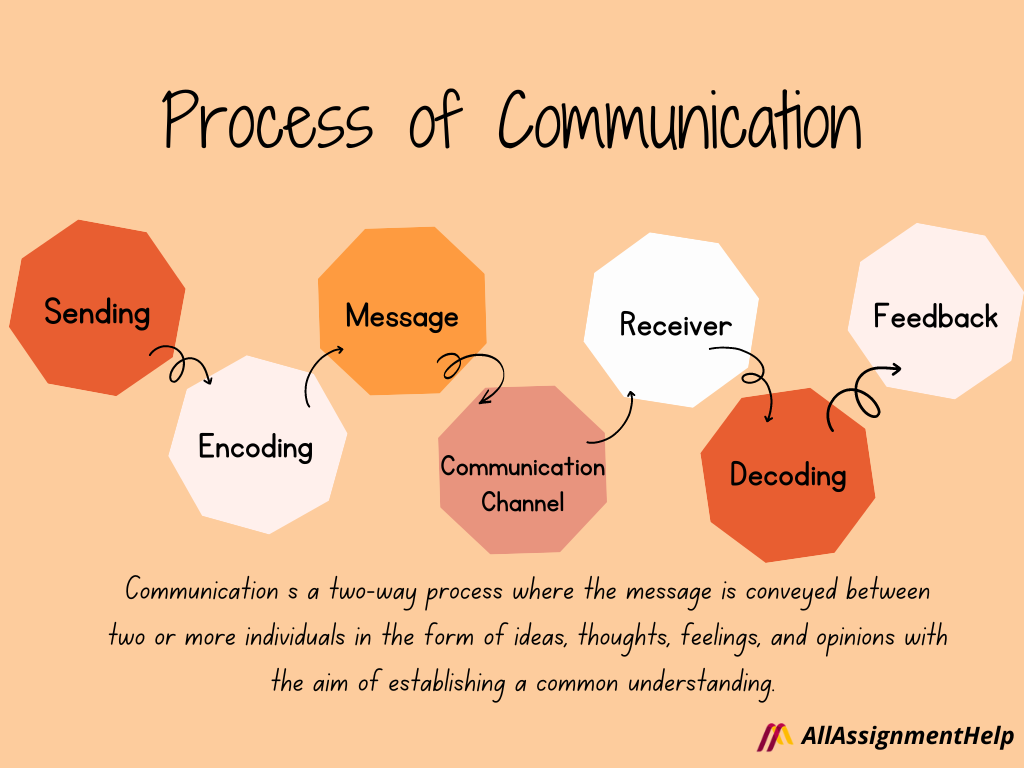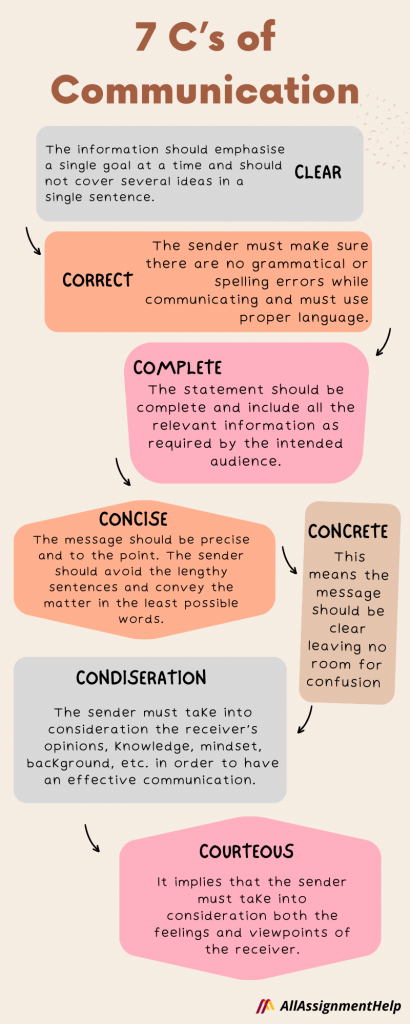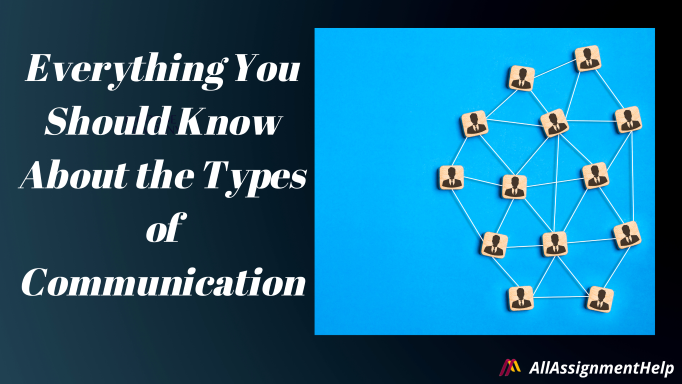Communication is an essential part of our daily lives. This is a process by which we get to share all our inner and outer feelings with others. But communicating in the right way is important because, on average, we communicate with 10 to 20 people daily. If you are not able to convey your part, then it is very difficult to achieve the best results. In a student’s situation, written communication requires the most focus. All the assignments, tests, and examination papers are examples of the same. Apart from written communication, there are different types of communication that students must be aware of. It is impossible to comprehend this idea on its own because it is so vast. If you are also lacking knowledge in this aspect, then I would suggest you read this write-up fully.
Allassignmenthelp.com has created this blog post to give students a better understanding of the communication process and the different types of communication.
What Is Communication?
The Latin word “communism,” which meaning “to share,” is where the word “communication” originates. It is a two-way process where the message is conveyed between two or more individuals in the form of ideas, thoughts, feelings, and opinions with the aim of establishing a common understanding. Simply said, communication is the act of passing on desired knowledge and comprehension to another person. Effective communication occurs when the sender’s message is received exactly as intended by the recipient. I think I have made the term communication clear to you. Let’s just get a good understanding of the communication process.
Also Read: The Most Intriguing Communication Research Ideas for Students
Process of Communication
To understand the types of communication effectively, we must first have knowledge of the whole process of working. So now let’s briefly go over the entire stages of this process.

1. Sending
The process first starts with the sender. The sender, or communicator, is the person who initiates the conversation and has conceptualised the idea that he intends to convey to others.
2. Encoding
The encoding process is wherein the sender uses certain words or non-verbal methods such as symbols, signs, or body gestures to translate the information. The sender’s knowledge, skills, perception, background, and competencies have a great impact on the success of the message.
3. Message
The message may be conveyed orally, in writing, symbolically, nonverbally—through body language, silence, sighs, sounds, or any other means—or it may be nonverbally expressed.
4. Communication Channel
The communication process is the medium through which the sender conveys his message to the recipient. It must be selected carefully in order to make the message effectively interpreted by the recipient. The choice of medium depends on the interpersonal relationships between the sender and the receiver and also on the urgency of the message being sent. The three most frequently used channels are oral, virtual, and written.
5. Receiver
The receiver is the person for whom the message is intended. The degree to which the receiver decodes the message depends on his knowledge of the subject matter, experience, trust, and relationship with the sender.
6. Decoding
The receiver evaluates the sender’s message during decoding and makes every effort to fully comprehend it.
7. Feedback
Feedback is the final step of the process that ensures the receiver has received the message and interpreted it correctly as intended by the sender. This is something that is also important in all types of communication. It increases the effectiveness of the communication as it permits the sender to know the efficacy of his or her message.
Types of Communication
There are several sorts of communication depending on where it is conveyed when it comes to categorising it. While moving forward in this blog, we will be discussing each of them in a detailed manner. The following list of communication styles is based on the status of those involved in the exchange and the criticality of the message being sent:
Types of Communication Based on Style and Purpose
1. Formal Communication
This is the first one among the types of communication. It is the exchange of official information that flows along the different levels of the organizational hierarchy. This is under the chain of command’s supervision, complies with all laws, and abides by all professional organisational policies, standards, processes, and rules.
The various formal forms of communication include the following:
a) Downward Communication
“Downward communication” is the common form of formal communication wherein information flows downwards, i.e., from the people occupying top positions in the organization to the people at lower levels. Depending on how long and important the communication is, it can be written or spoken and includes directives and orders. Reports, emails, letters, manuals, etc. are a few examples of this process.
b) Upward Communication
“Upward communication” is the transfer of information from the level of management to the level of subordinates. Here, communication can be in the form of requests, reports, suggestions, complaints, and instructions.
c) Lateral or Horizontal Communication
Horizontal communication means when co-workers with different areas of responsibility, but at the same level in the organisation communicate with each other. Communication between the managers of different departments, such as marketing, finance, production, and HR, is the best example of horizontal communication.
d) Crosswise Communication
When the employees of different departments at different levels communicate with each other irrespective of the chain of command, then the communication is said to be diagonal or crosswise communication. The communication between the floor manager and the sales team is an example of this.
Being a student, your formal communication also includes the VIVAs, numerous assignments, and other such things. If you want to give your best in it, learn and understand your course well. If you want someone to help in this aspect, you can anytime pay someone to do your homework and score good grades..
2. Informal Communication
The second type of communication is the informal one. It is the unofficial form wherein information is exchanged spontaneously between two or more people without conforming to the prescribed official rules, processes, systems, formalities, and chain of command. It is based on personal or informal relationships such as friends, peers, family, and club members and is free of organisational rules and other formalities. In the business context, this is characterised by an indefinite channel of communication, which means there is no definite chain of command through which the information flows. Hence, information can flow from anywhere.
There are four types of communication in an informal sense:
- Single Strand Chain
- Gossip Chain
- Probability Chain
- Cluster Chain
Types of Communication Based on Different Channels
I) Verbal Communication
Verbal communication is wherein you speak your subject matter, and others listen to it carefully and try to associate meaning with it. In this form of oral communication, the spoken word serves as the medium for the message to be delivered. Here the sender gives words to his feelings, ideas, and expresses them in the form of speeches, discussions, and conversations. The effectiveness of verbal communication depends on the tone, clarity, volume, speed, body language, and the quality of words. The sender must keep his speech tone high and clearly audible to all and must design the subject matter keeping the target audience in mind. To make sure the message is understood exactly as intended, the sender should always double-check with the recipient. Such communication is more prone to errors as sometimes the words are not sufficient to express the feelings and emotions of a person. The success of verbal communication depends not only on the speaking ability of an individual but also on their listening skills. How effectively an individual listens to the subject matter decides the effectiveness of the communication.
II) Non- Verbal Communication
It is the process of conveying meaning without the use of words. Non-verbal communication, to put it simply, is any communication between two or more individuals that involves the use of facial expressions, hand gestures, body language, postures, and gestures. People use non-verbals to express emotions and interpersonal attitudes, conduct rituals such as greetings, and bring forward their personalities. Communicating in the form of signals and expressions adds meaning to verbal communication and allows people to communicate more effectively. It also regulates the flow of communication. For example, an individual can give signals to convey that he has finished speaking or else that he wants to speak. Nonverbals can sometimes be a barrier to effective communication because the recipient may not understand what the sender is trying to say or may interpret it incorrectly.
III) Written Communication
It refers to the process of conveying a message through written symbols. In other terms, “written communication” refers to any message sent between two or more persons using written language. Written communication is the most common and effective mode of business communication. The most often utilised written forms of communication in any organisation are electronic mail, memos, reports, documents, letters, journals, job descriptions, employee manuals, etc. The effectiveness of written content depends on the correct choice of words within the correct sentence structure and the cohesiveness of the sentences. Written information is thought to be more legitimate and legal than spoken information. Additionally, consumers rely more on written content than verbal communication. The feedback of written communication is not immediate since it is not spontaneous and requires time to get into an understandable form.
Also Read: Online Courses to Improve Your Interpersonal Communication Skills
Once you go have gone through types of communication, here is the time to know 7C’s of communication
7 C’s of Communication

- Clear: The message should be clear and easily understandable, then only the receiver will be sure about it. The information should emphasise a single goal at a time and should not cover several ideas in a single sentence.
- Correct: The sender must make sure there are no grammatical or spelling errors while communicating and must use proper language. Also, the message should be exact and well-timed. Correct messages have a greater impact on the receiver, and the morale increases only with accuracy.
- Complete: The statement should be complete and include all the relevant information as required by the intended audience. The complete information helps in better decision-making by the recipient.
- Concrete: This means the message should be clear leaving no room for misinterpretation. To fully comprehend what the sender is saying, all the facts and data must be stated in precise detail.
- Concise: The message should be precise and to the point. The sender should avoid the lengthy sentences and convey the matter in the least possible words. The short and brief message is more comprehensive and helps in retaining the receiver’s attention.
- Consideration: The sender must take into consideration the receiver’s opinions, knowledge, mindset, background, etc. in order to have an effective communication.
- Courteous: It implies that the sender must take into consideration both the feelings and viewpoints of the receiver. The message must not be prejudicial and must use language that respects the recipient.
If you are a business student, it is highly essential for you to know about communication as it is related to the course. If you’re unclear on the terms, you can pay someone to do your assignment. There are many professionals ready to help you.
What Is Effective Communication?
Communication is said to be effective when all the parties (sender and receiver) in the communication assign similar meanings to the message and listen carefully to what has been said. In the business context, communication is effective if the information shared among the company’s employees contributes to the organisation’s commercial success. Using appropriate language and other abilities, such as comprehension, active listening, the capacity for forceful speech, etc., can help achieve this. Effective communication in the workplace is important as it allows employees to connect with others more deeply and improve teamwork, decision-making, and problem-solving abilities.
Also Read: Need of Effective Communication Skills in Today’s World
The following are the hurdles which can prevent us from communicating effectively. Don’t forget to have a look at it.
Barriers to Effective Communication
There are different kinds of barriers which stop effective communication. They are all listed below:
Semantic Barriers
- Faulty Translation: This entails communicating information regardless of the recipient’s level of comprehension.
- Unclarified Assumptions: A typical obstacle is making assumptions about topic and concentrating entirely on it without taking the receivers’ viewpoints.
- Denotations and Connotations: The denotation means the literal meaning of the word, it just shows the name of the object and does not imply any negative or positive qualities.
- Technical jargon: Engineers, production managers, IT managers, and others who work in technical fields frequently communicate with one another using technical jargon that is difficult for the average person to grasp.
- Bad Expression: The recipient can interpret the communication incorrectly since the formatting is poor and the language is complex.
- Symbols, or Words with Different Meanings: Many words have several meanings, and because people come from diverse social and educational backgrounds, they can cause misunderstandings and lead to varied interpretations.
Organisational Barriers
- Rules and Policies: Organisations that use specific messaging, media, and communication techniques without taking other people’s comfort into account.
- Organisational Facilities: Problems with organisational facilities like telephones, stationery, and translators can cause difficulty in communicating.
- Complex Structure: If there are more management levels inside the organisation, interaction diminishes.
Psychological Barriers
- Lack of Attention: When someone is preoccupied with something else and not paying close attention to what the other person is saying, interaction problems occur.
- Premature Evaluation: Many people have a tendency to jump to the conclusions directly and form judgements without considering all the aspects of information.
- Poor Retention: This refers to the capacity of a brain to retain or store things in the memory.
- Loss by Transmission: It denotes a decrease in information quality with the exchange of people.
Personal Barriers
- Listening Skills: When the recipient merely listens with his ears and makes no mental effort, communication becomes less effective.
- Selective Attention: This problem arises when the person is impatient and puts his objective above all.
- Lack of vocabulary: Often, the communication problem arises when the sender uses some words which are difficult for the receiver to comprehend correctly.
Also Read: Communication techniques and the importance of good communication skills
Conclusion
So, it’s a wrap here. From formal to informal, and from verbal to written communication every form specific has its own criteria. The types of communication are more in count but the best part is learning them is never too hard. All it needs is dedication and information (which is right above). If you still feel a need for professional assistance then you can hire an expert from ‘Do my assignment’ services and clear all your doubts.
Frequently Asked Questions
| Question 1: What is effective communication? Answer: Effective communication is a communication between two or more people wherein the intended message is successfully delivered, received, and understood. This is a skill that is learned and an individual can gain spontaneity in it by putting in extra effort and participating in more public conversations. |
| Question 2: What are the different communication styles by which one can communicate? Answer: As we all know, each person is different from the others, and so is their communication style. Some of the common communication styles used by people are passive, aggressive, passive-aggressive, and assertive. |
